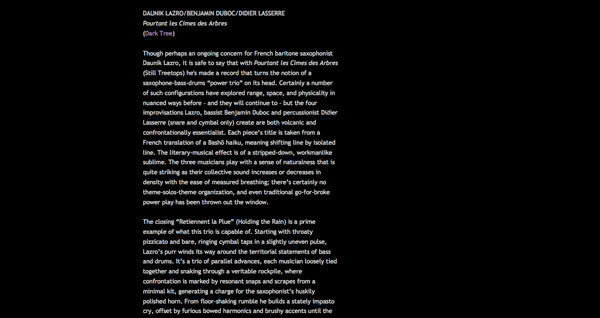• Chronique par Clifford Allen sur Ni Kantu (24 décembre 2011)
Though perhaps an ongoing concern for French baritone saxophonist Daunik Lazro, it is safe to say that with Pourtant les Cimes des Arbres (Still Treetops) he’s made a record that turns the notion of a saxophone-bass-drums “power trio” on its head. Certainly a number of such configurations have explored range, space, and physicality in nuanced ways before – and they will continue to – but the four improvisations Lazro, bassist Benjamin Duboc and percussionist Didier Lasserre (snare and cymbal only) create are both volcanic and confrontationally essentialist. Each piece’s title is taken from a French translation of a Bashō haiku, meaning shifting line by isolated line. The literary-musical effect is of a stripped-down, workmanlike sublime. The three musicians play with a sense of naturalness that is quite striking as their collective sound increases or decreases in density with the ease of measured breathing; there’s certainly no theme-solos-theme organization, and even traditional go-for-broke power play has been thrown out the window.
The closing “Retiennent la Plue” (Holding the Rain) is a prime example of what this trio is capable of. Starting with throaty pizzicato and bare, ringing cymbal taps in a slightly uneven pulse, Lazro’s purr winds its way around the territorial statements of bass and drums. It’s a trio of parallel advances, each musician loosely tied together and snaking through a veritable rockpile, where confrontation is marked by resonant snaps and scrapes from a minimal kit, generating a charge for the saxophonist’s huskily polished horn. From floor-shaking rumble he builds a stately impasto cry, offset by furious bowed harmonics and brushy accents until the group decides on torqued long tones and declamatory froth.
Lasserre’s kit deserves special mention – playing only a ride cymbal and snare drum, his approach recalls the portable necessity of Sunny Murray and John Stevens without a bop-inflected level of quickness. Lasserre marks time and creates decisive actions that shape the ensemble’s flow in an unpretentious, simple and direct fashion. That said he still gets a range of sounds and kinetics out of minimal instrumentation – witness the unearthliness of rolled sticks on the opening “Une Lune Vive” (The Quick Moon) as they set the stage for microtonal crackle and bellows. Narrowly-defined, tense clusters are worried into a frenzy and released ever so slightly as waves, flutter-tongue and arco approximate the earth along a fault line. Col legno patter, metronomic whine and subtonal sputter become the trio’s language in the piece’s next section with similarly narrow and equally effectual spacing. The power of Pourtant les Cimes des Arbres is in relatively simple iterations of mass and distance, but these are drawn out of three very distinct personalities.
• • • • • • • • • • • • • • • • • • • • • • • • • • • • • • • • • • • • • • • • • • • • • • • • • • • • • • • • • • • • • • • •

Sorry, the comment form is closed at this time.